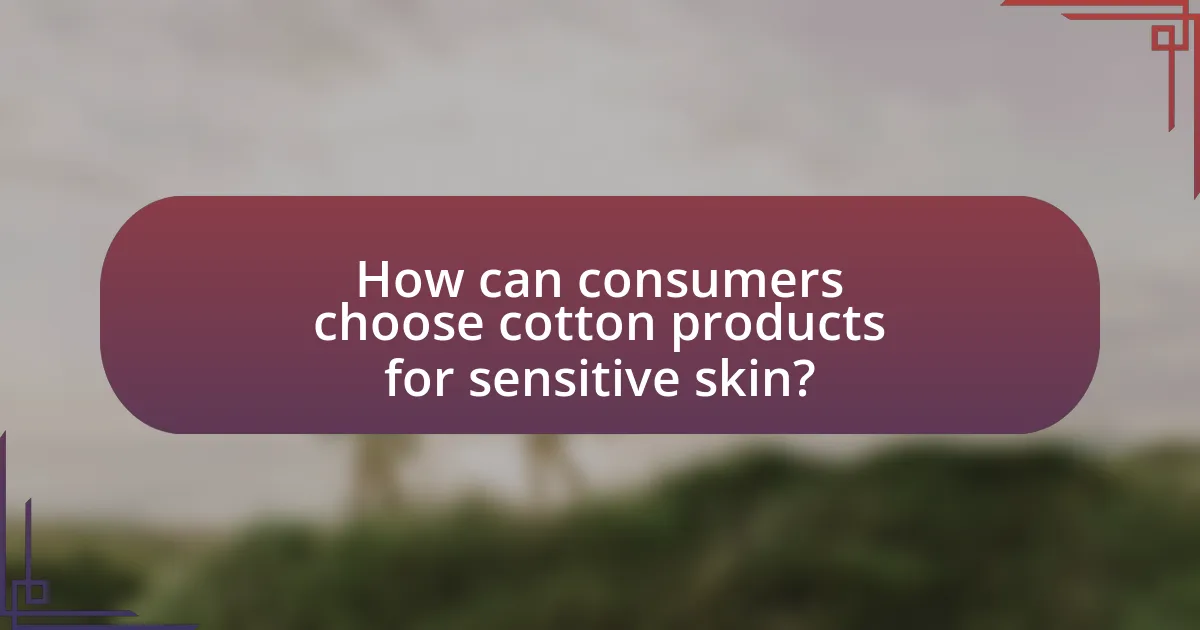Cotton is recognized for its hypoallergenic properties, making it a suitable fabric for individuals with sensitive skin. The article explores how cotton’s natural fibers, lack of harsh chemicals, and moisture-wicking abilities contribute to its classification as hypoallergenic. It compares cotton to synthetic fabrics, highlighting the common allergens found in other materials and the benefits of using organic cotton. Additionally, the article discusses the importance of hypoallergenic fabrics for various skin conditions, the impact of cotton processing on its hypoallergenic status, and practical tips for consumers to select suitable cotton products.

What are the hypoallergenic properties of cotton?
Cotton possesses hypoallergenic properties primarily due to its natural fibers, which are less likely to irritate the skin compared to synthetic materials. The absence of harsh chemicals in the production of organic cotton further enhances its suitability for individuals with sensitive skin. Studies indicate that cotton is breathable and moisture-wicking, reducing the likelihood of skin irritation and allergic reactions. Additionally, cotton’s low propensity for harboring dust mites and other allergens supports its classification as a hypoallergenic fabric, making it a preferred choice for bedding and clothing for those prone to allergies.
How does cotton compare to other fabrics in terms of hypoallergenic qualities?
Cotton is generally more hypoallergenic compared to many synthetic fabrics, making it a preferred choice for individuals with sensitive skin. This is primarily due to its natural fibers, which are less likely to irritate the skin or cause allergic reactions. In contrast, synthetic fabrics like polyester and nylon can trap moisture and heat, potentially leading to skin irritation and allergic responses. Studies have shown that cotton’s breathability and moisture-wicking properties contribute to its hypoallergenic qualities, as they help maintain a comfortable skin environment.
What specific allergens are commonly found in other fabrics?
Common allergens found in other fabrics include dust mites, mold spores, pet dander, and certain synthetic fibers like polyester. Dust mites thrive in various textiles, leading to allergic reactions in sensitive individuals. Mold spores can accumulate in damp fabrics, triggering respiratory issues. Pet dander, often found in household textiles, can cause allergic responses as well. Additionally, synthetic fibers like polyester may contain chemicals that can irritate the skin or provoke allergies. Studies indicate that natural fibers, such as cotton, are less likely to harbor these allergens, making them a preferable choice for those with sensitive skin.
How does cotton’s natural composition contribute to its hypoallergenic nature?
Cotton’s natural composition contributes to its hypoallergenic nature primarily due to its organic fibers, which are less likely to irritate the skin compared to synthetic materials. The cellulose structure of cotton fibers allows for breathability and moisture absorption, reducing the likelihood of skin irritation and allergic reactions. Additionally, cotton is free from harmful chemicals and dyes that can trigger allergies, making it a safer choice for individuals with sensitive skin. Studies have shown that cotton’s natural properties, such as its softness and lack of irritants, significantly lower the risk of allergic responses, reinforcing its reputation as a hypoallergenic fabric.
Why is hypoallergenic fabric important for sensitive skin?
Hypoallergenic fabric is important for sensitive skin because it minimizes the risk of allergic reactions and irritation. Sensitive skin often reacts adversely to common allergens found in traditional fabrics, such as dyes, chemicals, and synthetic fibers. Hypoallergenic materials, like cotton, are typically free from these irritants, making them safer for individuals with skin sensitivities. Studies have shown that using hypoallergenic fabrics can significantly reduce skin discomfort and allergic responses, thereby promoting overall skin health.
What skin conditions benefit from hypoallergenic materials?
Hypoallergenic materials benefit skin conditions such as eczema, psoriasis, and contact dermatitis. These conditions often involve heightened sensitivity and irritation from allergens and irritants found in various fabrics. Hypoallergenic materials, like certain types of cotton, are designed to minimize allergic reactions and skin irritation, making them suitable for individuals with these skin conditions. Studies have shown that using hypoallergenic fabrics can significantly reduce symptoms and improve comfort for those affected by these skin issues.
How can hypoallergenic fabrics improve overall skin health?
Hypoallergenic fabrics can improve overall skin health by reducing the risk of allergic reactions and irritation. These fabrics, such as cotton, are designed to minimize exposure to allergens like dust mites, mold, and certain chemicals that can exacerbate skin conditions. Studies indicate that cotton, known for its breathability and softness, helps maintain skin moisture and reduces friction, which can prevent rashes and discomfort. Additionally, hypoallergenic materials are often free from harsh dyes and synthetic fibers, further decreasing the likelihood of skin irritation.
What factors influence cotton’s hypoallergenic properties?
Cotton’s hypoallergenic properties are influenced by its natural fiber composition, processing methods, and environmental factors. The natural cellulose structure of cotton fibers makes them less likely to irritate sensitive skin compared to synthetic materials. Additionally, the absence of chemical treatments during cultivation and processing, such as pesticides and dyes, enhances cotton’s hypoallergenic qualities. Research indicates that organic cotton, which is grown without harmful chemicals, significantly reduces the risk of allergic reactions. Furthermore, the moisture-wicking ability of cotton helps maintain skin dryness, minimizing irritation and promoting comfort for individuals with sensitive skin.
How does the processing of cotton affect its hypoallergenic status?
The processing of cotton can significantly impact its hypoallergenic status by introducing potential allergens through chemical treatments and mechanical processes. For instance, the use of pesticides during cotton cultivation and the application of harsh chemicals during processing, such as bleach or formaldehyde, can leave residues that may trigger allergic reactions in sensitive individuals. Additionally, mechanical processing can create microfibers that may irritate the skin. Studies indicate that organic cotton, which is processed without synthetic chemicals, tends to have a higher hypoallergenic status compared to conventionally processed cotton, as it minimizes exposure to these potential allergens.
What chemicals are commonly used in cotton processing that may cause reactions?
Chemicals commonly used in cotton processing that may cause reactions include sodium hydroxide, hydrogen peroxide, and various dyes and finishing agents. Sodium hydroxide, used in the mercerization process, can cause skin irritation. Hydrogen peroxide, often employed for bleaching, may lead to allergic reactions in sensitive individuals. Additionally, synthetic dyes and finishing agents can contain allergens or irritants, potentially triggering skin reactions in those with sensitivities.
How can organic cotton be a better option for sensitive skin?
Organic cotton is a better option for sensitive skin because it is grown without synthetic pesticides and fertilizers, which can irritate the skin. The absence of these chemicals reduces the risk of allergic reactions and skin sensitivities. Additionally, organic cotton is often processed without harsh chemicals, making it gentler on the skin. Studies have shown that organic cotton fabrics have lower levels of harmful residues compared to conventional cotton, further supporting their suitability for individuals with sensitive skin.
What role does cotton’s weave and texture play in its hypoallergenic properties?
Cotton’s weave and texture significantly contribute to its hypoallergenic properties by allowing for breathability and moisture absorption. The natural fibers of cotton, combined with a loose weave, create a fabric that minimizes skin irritation and reduces the likelihood of allergic reactions. This is supported by the fact that cotton is less likely to harbor dust mites and other allergens compared to synthetic materials, which can trap heat and moisture. Additionally, the smooth texture of cotton reduces friction against the skin, further decreasing the risk of irritation for individuals with sensitive skin.
How do different weaves affect breathability and skin irritation?
Different weaves significantly influence breathability and skin irritation, with tighter weaves generally reducing airflow and potentially increasing irritation. For instance, a plain weave offers moderate breathability, while a loose weave, such as a percale, enhances airflow, making it less likely to trap moisture and heat against the skin. Research indicates that fabrics with higher breathability, like those made from loosely woven cotton, are less likely to cause skin irritation, as they allow sweat to evaporate and reduce friction. This is particularly important for individuals with sensitive skin, as studies show that increased breathability correlates with lower instances of irritation and discomfort.
What textures are most suitable for sensitive skin?
Soft, smooth, and breathable textures are most suitable for sensitive skin. These textures minimize irritation and allow for better airflow, which is crucial for maintaining skin comfort. Fabrics like cotton, bamboo, and silk are ideal as they are hypoallergenic and gentle against the skin. Research indicates that cotton, in particular, has properties that reduce the risk of allergic reactions, making it a preferred choice for individuals with sensitive skin.

How can consumers choose cotton products for sensitive skin?
Consumers can choose cotton products for sensitive skin by selecting 100% organic cotton items, as these are less likely to contain harmful chemicals or irritants. Organic cotton is grown without synthetic pesticides and fertilizers, reducing the risk of skin reactions. Additionally, consumers should look for products labeled as hypoallergenic, which indicates they are specifically designed to minimize allergic reactions. Certifications from reputable organizations can also provide assurance of the product’s quality and safety for sensitive skin.
What labels or certifications should consumers look for in cotton products?
Consumers should look for labels and certifications such as GOTS (Global Organic Textile Standard), OEKO-TEX Standard 100, and USDA Organic when purchasing cotton products. GOTS ensures that the cotton is organic and produced in an environmentally and socially responsible manner, while OEKO-TEX Standard 100 certifies that the fabric is free from harmful substances, making it suitable for sensitive skin. USDA Organic certification guarantees that the cotton is grown without synthetic pesticides or fertilizers, further supporting hypoallergenic properties. These certifications provide assurance of quality and safety for consumers, particularly those with sensitivities.
How do certifications ensure the hypoallergenic quality of cotton?
Certifications ensure the hypoallergenic quality of cotton by verifying that the cotton is produced without harmful chemicals and allergens. These certifications, such as Oeko-Tex Standard 100 and GOTS (Global Organic Textile Standard), require rigorous testing for substances that could trigger allergic reactions, including pesticides, heavy metals, and synthetic additives. For instance, Oeko-Tex Standard 100 tests for over 100 harmful substances, ensuring that the final product is safe for sensitive skin. This systematic approach to testing and certification provides consumers with confidence that the cotton they are purchasing meets strict hypoallergenic criteria.
What are the best practices for selecting hypoallergenic cotton products?
To select hypoallergenic cotton products effectively, prioritize items labeled as “100% organic cotton” or “certified hypoallergenic.” These labels indicate that the cotton is grown without harmful chemicals and processed without allergens. Additionally, examine the product’s certifications, such as the Global Organic Textile Standard (GOTS), which ensures that the cotton meets strict environmental and safety criteria. Research shows that organic cotton reduces the risk of skin irritation, making it suitable for sensitive skin. Furthermore, avoid products with dyes, fragrances, or synthetic additives, as these can trigger allergic reactions.
What are some common misconceptions about cotton and hypoallergenic properties?
A common misconception about cotton is that it is inherently hypoallergenic, which is not always true. While cotton is a natural fiber that is less likely to cause allergic reactions compared to synthetic materials, it can still harbor allergens such as dust mites, mold, and pollen if not properly maintained. Additionally, some individuals may react to chemical treatments used in cotton processing, such as dyes and finishes, which can contribute to skin irritation. Research indicates that untreated, organic cotton is less likely to provoke allergic reactions, but the presence of allergens in the environment and processing methods can still affect its hypoallergenic properties.
Why do some people believe cotton can cause allergies?
Some people believe cotton can cause allergies due to the presence of natural substances, such as proteins and chemicals used in processing. These substances can trigger allergic reactions in sensitive individuals. For instance, cotton may be treated with pesticides or dyes that can irritate the skin or respiratory system, leading to symptoms like rashes or asthma. Additionally, the fibers of cotton can harbor dust mites and mold, which are known allergens. Studies have shown that exposure to these allergens can exacerbate allergic reactions, reinforcing the belief that cotton may not be as hypoallergenic as commonly thought.
How can education help dispel myths about cotton and sensitive skin?
Education can dispel myths about cotton and sensitive skin by providing accurate information on cotton’s natural properties and its benefits for sensitive skin. Research indicates that cotton is a breathable, hypoallergenic fabric that minimizes irritation, making it suitable for individuals with sensitive skin. For instance, a study published in the Journal of Dermatological Science highlights that cotton’s moisture-wicking ability helps reduce skin irritation and allergic reactions compared to synthetic fabrics. By educating consumers on these facts, misconceptions can be addressed, leading to informed choices regarding fabric selection for sensitive skin.
What practical tips can help consumers maximize the benefits of cotton for sensitive skin?
To maximize the benefits of cotton for sensitive skin, consumers should choose 100% organic cotton products, as they are free from harmful chemicals and pesticides that can irritate the skin. Additionally, washing cotton items with fragrance-free, hypoallergenic detergents before use can further reduce the risk of irritation. Research indicates that organic cotton is less likely to cause allergic reactions due to its natural cultivation methods, which avoid synthetic fertilizers and pesticides. Furthermore, opting for tightly woven cotton fabrics can provide a barrier against allergens while remaining breathable, enhancing comfort for sensitive skin.





